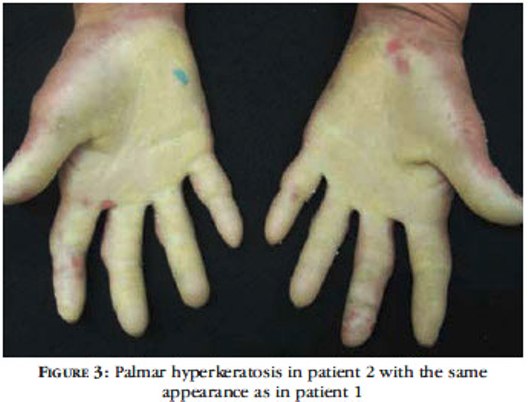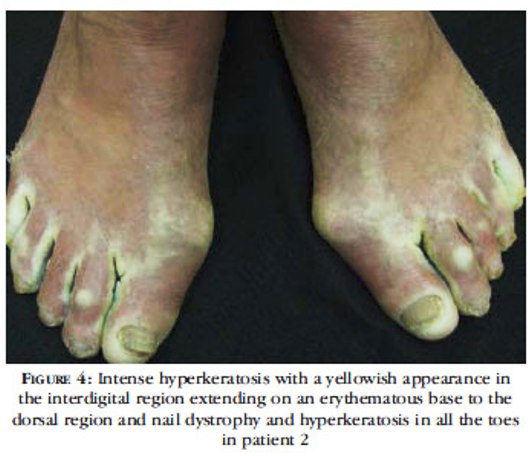
Intense hyperkeratosis producing a yellowish color interwoven with an erythematous border in the palmar region of a patient.
Here we describe the cases of two patients from the same family with typical clinical pictures and a history of consanguinity between the parents. The cases illustrate a rare genodermatosis that should be part of the differential diagnosis of palmoplantar keratodermas.
Case Reports

She reported that her parents had had 6 children, 3 of whom were healthy and 3 of whom suffered from the disease (her, the patient in case 2 and another sibling, who had died of another cause). Dermatological examination revealed intense transgressive whitish-yellow palmoplantar hyperkeratosis with maceration, and erythema extending to the dorsa of the feet and hands. Hyperkeratosis of the nails on all the fingers and toes was also present (Figures 1 and 2). Laboratory tests were normal. A clinical diagnosis of Mal de Meleda was made. However, the patient refused any specific treatment (systemic retinoids) and chose treatment with emollients.
Case 2: BDC, 72 years old, female, sister of patient 1, born and living in Mogi das Cruzes presented with a complaint of desquamation on her feet and hands since birth and the development of painful fissures. She also complained of excessive sweating and lesions with a fetid odor but denied any lesions on other parts of her body.


* Arredondo J, Chernyavsky AI, Webber RJ, Grando SA. Biological effects of SLURP-1 on human keratinocytes. J Invest Dermatol. 2005 Dec;125(6):1236-41.
* Chimienti F, Hogg RC, Plantard L, Lehmann C, Brakch N, Fischer J, Huber M, Bertrand D, Hohl D. Identification of SLURP-1 as an epidermal neuromodulator explains the clinical phenotype of Mal de Meleda. Hum Mol Genet. 2003 Nov 15;12(22):3017-24. Epub 2003 Sep 23.
* Eckl KM, Stevens HP, Lestringant GG, Westenberger-Treumann M, Traupe H, Hinz B, Frossard PM, Stadler R, Leigh IM, Nürnberg P, Reis A, Hennies HC. Mal de Meleda (MDM) caused by mutations in the gene for SLURP-1 in patients from Germany, Turkey, Palestine, and the United Arab Emirates. Hum Genet. 2003 Jan;112(1):50-6. Epub 2002 Oct 19.
* Favre B, Plantard L, Aeschbach L, Brakch N, Christen-Zaech S, de Viragh PA, Sergeant A, Huber M, Hohl D. SLURP1 is a late marker of epidermal differentiation and is absent in Mal de Meleda. J Invest Dermatol. 2007 Feb;127(2):301-8. Epub 2006 Sep 28.
* Fischer J, Bouadjar B, Heilig R, Huber M, Lefèvre C, Jobard F, Macari F, Bakija-Konsuo A, Ait-Belkacem F, Weissenbach J, Lathrop M, Hohl D, Prud'homme JF. Mutations in the gene encoding SLURP-1 in Mal de Meleda. Hum Mol Genet. 2001 Apr 1;10(8):875-80.
This health news has been brought to you by the publishers of Health Reviews, Tips and News Website. Visit today for great health tips and reviews.



No comments
Post a Comment